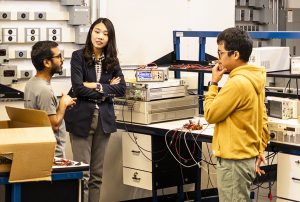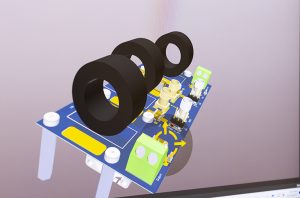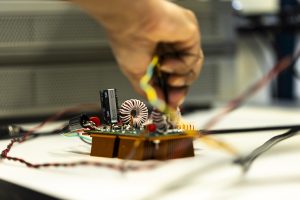By Wayne Gillam / UW ECE News

UW ECE Assistant Professor Jungwon Choi is engineering high-frequency power converters for advanced and emerging technologies, such as electric vehicles, artificial intelligence, robotics, biomedical devices, and renewable energy systems. Photo by Ryan Hoover / UW ECE
We live in a world powered by electricity. But few people stop to think about where that power comes from, let alone how it is transformed to run the devices they use every day. Electrical energy can be generated from fossil fuels or renewable sources, such as the sun, wind, and flowing water. But we cannot plug this raw power directly into electronics. It must first be processed and optimized for specific systems and devices. This is the role of power electronics, a branch of electrical engineering focused on transforming electrical energy from one form to another. A good example of power electronics in everyday life are the power adapters used to charge smartphones and laptops. Each power adapter contains a small power converter that changes alternating electrical current from a wall outlet into a form the device can use.
Modern electronic systems have been rapidly evolving to support advanced and emerging technologies, such as autonomous vehicles, machine learning, artificial intelligence, and robotics. But while these technologies are changing fast, an efficient charging system for them has not yet been developed. In addition, countries worldwide are transitioning to renewable energy sources and systems that are electrified. As demand for clean energy grows, enabling technologies, such as photovoltaics, smart-grid systems, semiconductor devices, and power converters, become essential. It’s fair to say that power-electronic circuits will form the backbone of the next-generation electric grid. So, efficient power converter designs with high-power capacity will be crucial to improving the performance of the entire grid system. With these things in mind, engineering intelligent, compact, and efficient charging systems is a pressing need.
UW ECE Assistant Professor Jungwon Choi is conducting research that addresses this challenge and points toward the future, bridging state-of-the-art power electronics and the needs of modern technology. Her aim is to miniaturize power electronics circuits and optimize them for wireless technologies. This work is focused on enabling compact and reliable power conversion systems for electrification as well as extending these systems to provide wireless power transfer.
“I try to break down the walls that prevent us from improving the power density of applications,” Choi said. “In other words, I engineer power converters to improve their power capacity and efficiency for emerging technologies, such as electric vehicles, robotics, biomedical devices, and renewable energy systems. My work is also for data centers that support new applications, such as advanced forms of artificial intelligence and machine learning.”
Academic background

Choi with UW ECE graduate students Ghovindo Siadari (left) and Manas Palmal (right) in the UW Power Electronics Research Lab. Choi’s lab focuses on power electronics and sustainable energy, power semiconductor devices, control systems, and magnetic designs. Photo by Dennis Wise / University of Washington
Choi’s interest in power electronics began at a young age, and she said it seemed natural for her to select electrical engineering as a major when pursuing her undergraduate degree. In 2009, she received her bachelor’s degree in electrical engineering from Korea University in Seoul, South Korea. She then worked for three years at KT Corporation, a Korean telecommunications company. While at KT, she decided that she wanted to go to graduate school. She moved from South Korea to the United States and studied at the University of Michigan, where, in 2013, she received her master’s degree in electrical engineering and computer science. She then went on to earn her doctoral degree in electrical engineering from Stanford University in 2019. After completing her doctoral degree, she accepted a position as an assistant professor at the University of Minnesota, where she focused on power electronics, power semiconductor devices, wireless power transfer, and magnetics.
In September 2023, Choi became an assistant professor at UW ECE. She said that she chose to join the Department because it offered many collaborative opportunities that were a good fit for her research as well as an outstanding curriculum for students. She also knew that Seattle was home to many potential industry partners. She realized that this combination could provide strong support for the direction her work was headed, while enabling her to teach more students about power electronics.
Choi’s collaborators in UW ECE include professors Daniel Kirschen, Baosen Zhang, and June Lukuyu, who are all experts in various aspects of power and energy systems. Choi is also a member of the Clean Energy Institute at the UW. In addition, she works with UW ECE Professor and Associate Chair for Research Mo Li in UPWARDS, a program aimed at providing advanced training and research opportunities that will grow the nation’s semiconductor workforce.
Choi has received many awards and honors in her career. In 2017, she was selected as one of the Rising Stars in EECS at Stanford University. In 2019 and 2020, she received Unlock Ideas awards from Lam Research, and in 2021, she received a National Science Foundation (NSF) CAREER Award. Earlier this year, she was selected for a secretary position in the IEEE Power Electronics Society (PELS) Technical Committee (TC2), focusing on power components, integration, and power integrated circuits.
The UW Power Electronics Research Lab

An illustration of a spiral coil design for wireless power transfer that Choi is working on with her students in the lab. Photo by Dennis Wise / University of Washington
Choi directs the UW Power Electronics Research Laboratory at the UW, which includes graduate students pursuing their master’s and doctoral degrees. Her lab focuses on power electronics and sustainable energy, power semiconductor devices, control systems, and magnetic designs. This work encompasses development of high-frequency power converters and wireless power transfer for battery-powered vehicles; industrial and biomedical applications; system controls at high frequencies; energy storage; and wide-bandgap devices — electronic components made from nontraditional semiconductor materials that can withstand higher voltages and operate at higher frequencies than silicon. Choi’s research applies to a broad range of applications and includes collaboration with leading technology companies and faculty from different disciplines.
For example, one of Choi’s main research projects is designing flexible charging systems for robots that move items, such as packages, from one place to another in factories and warehouses. The primary drawback of using these robots is that the time it takes to charge them is nearly as long as the time they spend working. Another challenge is that the systems used to charge the robots are large and unwieldy. Choi seeks to address these problems through a couple of different approaches. First, she and her research team are developing wireless power transfer pads that will allow the robots to charge autonomously without needing to be plugged into a physical adapter. When the robot parks itself over the pad, it will be charging. Second, Choi is devising ways to charge the robots while they are driving and working. This could greatly reduce or even eliminate altogether time spent on the charging pad. This second approach will require shrinking the size of the robot’s wireless charging system. To achieve this goal, Choi and her research team are developing many detailed and innovative modifications to the system’s power converter circuit and coil design.
“I find it fascinating to work on challenges in power electronics, not just by myself, but also with my graduate students and by collaborating with other researchers. Together, we can make next-generation circuits and devices, and by doing so, we can solve problems that no one has ever solved before.” — UW ECE Assistant Professor Jungwon Choi
Choi is also improving spiral coil designs for wireless power transfer systems operating at high frequencies. She has created several coil prototypes and, as described in one of her IEEE papers, she is using machine learning to optimize the coil design for energy efficiency and performance. This is a long-term project with broad applications. A key advantage of optimizing coil designs is that the efficiency of the power conversion system can be greatly improved. For wireless power transfer, power can also be sent over longer distances. This can benefit a wide range of technologies — from reducing the size of the power converters for electronic devices, to charging robots and vehicles while they are operating, to shrinking the size of biomedical equipment. Most recently, she has been collaborating with UW ECE Professor Maryam Fazel, who is helping Choi build machine learning algorithms capable of running coil design simulations in a fraction of the time they usually take.
In another recent project, Choi collaborated with Lam Research to engineer a more compact, energy-efficient source for generating plasma — a conductive, ionized gas. Plasma can be used to etch intricate patterns on silicon wafers and is a crucial part of the microchip manufacturing process. It takes a lot of power to generate plasma. Current plasma generation systems tend to be big and bulky, and they reside outside the vacuum chamber where plasma is created. The large size and physical location of the equipment lead to energy losses. Choi is continuing work on this project and intends to remedy these problems by reducing the size of the power conversion system and placing it inside the vacuum chamber, thereby increasing the energy efficiency of the power source.
Choi plans to share her research findings widely.
“Right now, the field is moving from low-frequency design to high-frequency design. But there is not that much knowledge out there about how to design high-frequency power converters, how to control them, or how we can use wireless power transfer with these high-frequency converters,” Choi said. “What I’m envisioning is improving power converter performance by collaborating with people from many different fields, including devices, machine learning, and systems. That way, we can produce a solid outcome and design a reliable, high-efficiency, high-frequency power converter while providing everyone with access to our techniques.”
Practical education for the next generation

A close-up of the spiral coil design prototype illustrated above. Photo by Dennis Wise / University of Washington
Choi teaches power electronics courses designed for undergraduate and graduate students. She constructs her courses to be engaging, fun, and to spark interest in the field. Choi said that she wants her students to experience how enjoyable studying and working with power electronics can be. She also considers the courses she teaches to be gateways for students to get into related fields, such as engineering electric vehicles or designing sustainable power systems.
Choi seeks to guide her students along the lines of their interests and to whatever field or endeavor might be a good fit for them. For her undergraduate students interested in making a career in power electronics, she recommends they review materials from their sophomore and junior-level circuit courses, building strong fundamental knowledge in basic circuits and electromagnetics. She said this knowledge is foundational and supports more complex concepts they will later learn. For graduate students, she recommends doctoral students do a summer internship because power electronics is an industry-based discipline. Choi said that graduate students need to be aware of what problems those in industry are grappling with, and then as academics, find ways to help solve those problems.
Outside of UW ECE, Choi is a faculty adviser for UW Formula Motorsports, which is a student organization that designs, builds, and races cars. Choi helps the students with power and electronics-related issues and guides them through engineering challenges and any other problems the group is trying to solve. In her spare time, Choi enjoys skiing with her family.
“As an educator, I really enjoy working with students. I not only mentor them, but sometimes, through our conversations, I might get a new idea and be inspired by them,” Choi said. “As a researcher, I find it fascinating to work on challenges in power electronics, not just by myself, but also with my graduate students and by collaborating with other researchers. Together, we can make next-generation circuits and devices, and by doing so, we can solve problems that no one has ever solved before.”
For more information about UW ECE Assistant Professor Jungwon Choi, visit her bio page.

